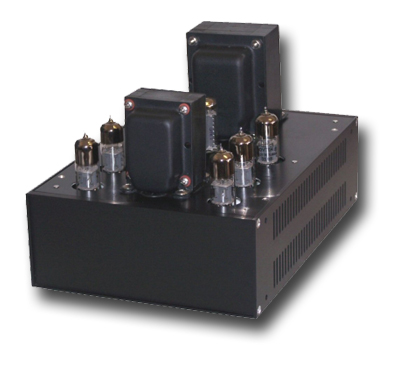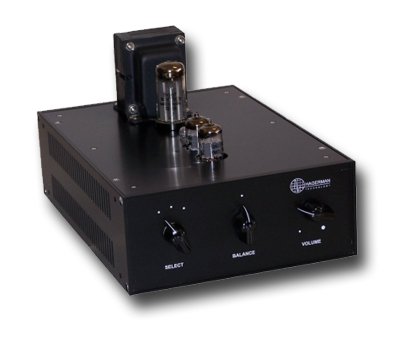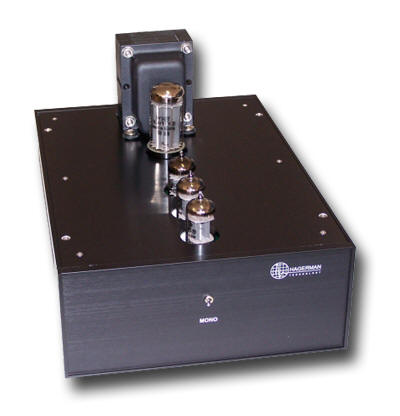|
You are reading the older HTML site
Positive Feedback
ISSUE
21
Kennedy on Audio -
Hagerman Technology Hits a Home Run with the
Clarinet Linestage, the Cornet 2 Phonostage, and the Cymbal Amplifiers
I recently received a pair of Cymbal push/pull monoblocks, a Clarinet linestage, and a Cornet 2 phonostage for review, all from Hagerman Technology (http://hagtech.com). These are normally available as raw boards, with the builders purchasing the required materials and assembling and testing the completed units. In my case, Hagerman provided assembled units, and for those not willing or able to source the required parts and do yeomanly metalwork, assembly, and testing, this is the best option. Each kit consists of a well-laid-out blank PCB and a manual containing a parts list, parts upgrade recommendations, chassis drawings, performance specs, and a schematic. The kits, which are clearly targeted at the more experienced hobbyist, require a wide range of skills for their successful completion. The designs are solidly designed and of considerable merit, and will provide results commensurate with the effort involved in assembling them. All feature zero-feedback operation, simple, well-thought-out circuits, and some interesting features, including tube rectification and indicator lamps on the chassis that change from red to green as the units warm up. Customer support and warranty provisions are also excellent, and Jim Hagerman is as helpful and knowledgeable a designer as I have encountered.
The amplifier runs silently, with no significant hum, buzz, hiss, or other artifacts audible through my rather efficient JBL Rhodes loudspeakers. Damping factor is 5, which is surprisingly high for a push/pull amplifier without global feedback. (As a reference, the damping factor of my 300B push/pull design is about 2.2 on an 8-ohm tap with an 8-ohm load.) This should make this amplifier a good match with any number of vented enclosures. I believe this amp would also be a good match with Quad 57s, though not the later, somewhat power-hungry Quad electrostats. The Cymbal sounded quick and agile. It had good bass extension and control with the JBLs. The highs were extended and fairly smooth. Midrange coloration was minimal. I would place this amplifier in the resolution-over-romanticism category, although it sounded quite smooth and pleasing—somewhat reminiscent of a good SE amplifier in the same power range. It is a neutral, truthful, balanced sounding amplifier that will allow the user to listen relatively deeply into the music with appropriate loudspeakers. The Cymbal’s low overall distortion and lack of compression (until it ran out of steam) belied its power rating, and it will play convincingly loud with any speaker of reasonable efficiency (over 92dB spl @ 2.83Vrms into 8 ohms—old-timers will remember this as 1W into 8 ohms). The kit version offers almost unlimited opportunities for customization. I recommend using the highest quality parts you can afford, as the design deserves it. VH caps would be a good choice, and for other items I recommend Michael Percy or Handmade Electronics as sources for high-quality parts. Like the Cymbal amp, the Clarinet preamp is a kit requiring considerable expertise to assemble. Again like the amplifier, it is an excellent design. The circuit is based on a pair of 12AU7As configured as SRPPs—an excellent topology for use with this tube. No electrolytic capacitors are present in the signal path. Quiescent current is around 7mA, which is a good point for linearity with this tube. Output impedance is reasonably low at 1Kohm, and the preamp should drive most amplifiers without difficulty. Power is provided by a 5Y3, which at these current levels should provide many years of service.
The Clarinet's approximate input impedance is 75Kohm with the balance pot centered (it varies with the position of the balance pot, from a low of around 50K to a high of 100K). I don’t think this will be an issue with the matching phono stage or solid-state source components, but the low input impedance may present issues with some vintage tube tuners. The unit features three line-level inputs and two sets of output jacks. The output impedance is low enough to drive two pairs of amplifiers and/or moderately long interconnects. I much prefer separate volume controls for each channel, as they eliminate an additional set of contacts in the signal path. A 100Kohm stereo DACT stepped attenuator (or a pair of monos) would be an excellent upgrade. Though the quality of the passive components will play a big role in the performance of the design, the recommended components will provide rather good performance. The Clarinet preamplifier is agile, detailed, and warm without being euphonic. It has excellent soundstaging, tonal balance, presence, and palpability. It is far better than any of the other kit preamplifiers I have heard to date, and is worth your serious consideration. Tube rollers will enjoy this preamp, as the differences between good Telefunken, Amperex, Mazda, and other 12AU7A/ECC82s are quite apparent. Really good ones will make this preamp sing. As with its brothers, building a Cornet 2 phono stage from scratch is required to enjoy its pleasures. I enjoyed this unit the most of the three, probably because I already had an excellent line stage and power amplifier, but this little phono stage completely trounced my sub-mini phono preamp, and sent me back to the drawing board.
The phono preamp was extremely quiet with my vintage Grado 8MR cartridge (not MC!). High-output moving coil types, with their low generator impedances, would provide a very good match in terms of low-noise operation. While the standard Cornet2 offers high performance, like the other two designs it is amenable to parts upgrades, and Hagerman stresses that the choice of parts is at the builder’s discretion. This is not a vintage-sounding phono preamp. While it sounds pleasant and definitely tube-based, it has resolution, soundstaging, and speed that no vintage design I know of can match. The sound is coherent, well balanced, and detailed. The critical midrange is warm without bloom, the bass solid and visceral when called for, the highs smooth. The preamp does not artificially accentuate the tracing noise from the cartridge on quiet passages, which probably indicates good ultrasonic linearity. At least one phono stage I have evaluated had this problem. These kits (and of course the built-up versions) represent solid yet innovative engineering. They are not just knockoffs of older designs. Their performance is excellent, and unlike many DIY projects, the results are guaranteed. You get the support and assistance of Hagerman Technology, a company that has been around for a long time. I heartily recommend these kits to those who have the skills to complete them. For most, I suspect, the biggest issue will be the extensive drilling and cutting needed for the chassis work. I recommend a good set of chassis punches. Beyond that, if you can follow instructions and solder competently, the likelihood of success is extremely good. All of the kits are clearly designed for stability, simplicity, and reliability. Troubleshooting, if required, will require little more than a DVM in most instances. Highly recommended!
Cornet 2 Phonostage
Cymbal 8W Amplifier
Clarinet Linestage
|

 The Cymbal amplifier is an interesting design that
employs a quartet of 6H30 dual triodes in a novel, cathode-biased, push/pull
parallel configuration capable of 6 watts rms at
≤
0.2% THD (@1kHz) with no global feedback. I verified this using my Amber 3501A.
Drive is provided by another 6H30 configured as a differential long-tailed pair,
utilizing a ring of two current sources for excellent AC balance and common mode
rejection. The output stage has provisions for optimizing DC balance. No
electrolytics are employed in the signal path. The amplifier’s input may be
switched between unbalanced and balanced operation to mitigate hum pickup from
the interconnects. The particularly intrepid user can fit this amplifier with
balanced XLR inputs in addition to the recommended RCA jacks if desired. Cool.
Power is provided by a single 5AR4 feeding a standard choke-based pi-filter.
Transformers are Hammond types, and are run very conservatively. The
transformers did not get excessively warm in operation, and were mechanically
quiet.
The Cymbal amplifier is an interesting design that
employs a quartet of 6H30 dual triodes in a novel, cathode-biased, push/pull
parallel configuration capable of 6 watts rms at
≤
0.2% THD (@1kHz) with no global feedback. I verified this using my Amber 3501A.
Drive is provided by another 6H30 configured as a differential long-tailed pair,
utilizing a ring of two current sources for excellent AC balance and common mode
rejection. The output stage has provisions for optimizing DC balance. No
electrolytics are employed in the signal path. The amplifier’s input may be
switched between unbalanced and balanced operation to mitigate hum pickup from
the interconnects. The particularly intrepid user can fit this amplifier with
balanced XLR inputs in addition to the recommended RCA jacks if desired. Cool.
Power is provided by a single 5AR4 feeding a standard choke-based pi-filter.
Transformers are Hammond types, and are run very conservatively. The
transformers did not get excessively warm in operation, and were mechanically
quiet.
 The design of the Cornet2 is deceptively simple,
with passive equalization split between the two 12AX7A-based amplifier stages. A
constant-current-loaded 12AU7A cathode follower output rounds out the
complement. I am a firm believer in passive equalization, which allows for some
optimization of high-frequency signal-to-noise ratio and dynamic range. The
first stage comprises the low-frequency constants of ~3180uSec and 318uSec,
while the second stage comprises the 75uSec roll-off. Note that the RP of the
tubes constitutes a significant portion of the equalizer time constants, so
users should stick to the recommended tube types. Once again, there are no
electrolytic capacitors in the signal path.
The design of the Cornet2 is deceptively simple,
with passive equalization split between the two 12AX7A-based amplifier stages. A
constant-current-loaded 12AU7A cathode follower output rounds out the
complement. I am a firm believer in passive equalization, which allows for some
optimization of high-frequency signal-to-noise ratio and dynamic range. The
first stage comprises the low-frequency constants of ~3180uSec and 318uSec,
while the second stage comprises the 75uSec roll-off. Note that the RP of the
tubes constitutes a significant portion of the equalizer time constants, so
users should stick to the recommended tube types. Once again, there are no
electrolytic capacitors in the signal path.